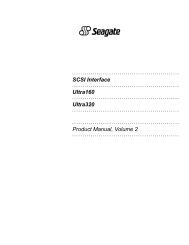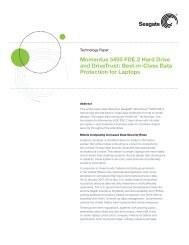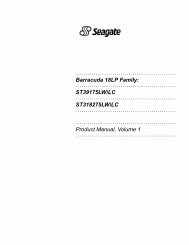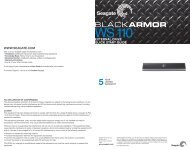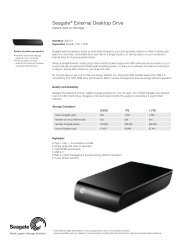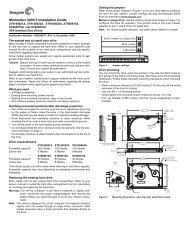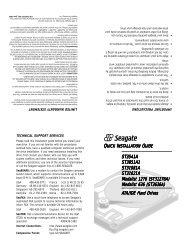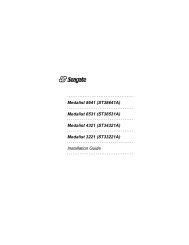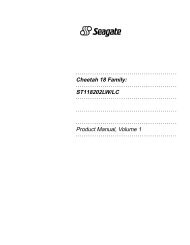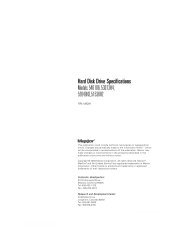Quickview 300 Product Manual PATA - Seagate
Quickview 300 Product Manual PATA - Seagate
Quickview 300 Product Manual PATA - Seagate
Create successful ePaper yourself
Turn your PDF publications into a flip-book with our unique Google optimized e-Paper software.
Installation<br />
Master or Slave with the CS feature, the CS jumper is installed (1). The<br />
drive's position on the 80 pin conductor Ultra ATA data cable then<br />
determines whether the drive is a Master (Device 0) or a Slave (Device<br />
1). If the drive is connected to the end of the Ultra (cable Select) data<br />
cable the drive is a Master. If the drive is connected to the middle<br />
connection it is set as a Slave.<br />
Once you install the CS jumper, the drive is configured as a Master or<br />
Slave by the state of the Cable Select signal: pin 28 of the <strong>PATA</strong> bus<br />
connector. Please note that pin 28 is a vendor-specific pin that Maxtor<br />
is using for a specific purpose. More than one function is allocated to<br />
CS, according to the <strong>PATA</strong> CAM specification (see reference to this<br />
specification in Chapter 1). If pin 28 is a 0 (grounded), the drive is<br />
configured as a Master. If it is a 1 (high), the drive is configured as a<br />
Slave. In order to configure two drives in a Master/Slave relationship<br />
using the CS jumper, you need to use a cable that provides the proper<br />
signal level at pin 28 of the <strong>PATA</strong> bus connector. This allows two drives<br />
to operate in a Master/Slave relationship according to the drive cable<br />
placement.<br />
The <strong>Quickview</strong> <strong>300</strong> <strong>PATA</strong> hard disk drives are shipped from the factory<br />
as a Master (Device 0 - CS jumper installed). To configure a drive as a<br />
Slave (Device 1- DS scheme), the CS jumper must be removed. In this<br />
configuration, the spare jumper removed from the CS position may be<br />
stored on the PK jumper pins.<br />
3.3.1.2 Drive Select (DS) Jumper<br />
You can also daisy-chain two drives on the <strong>PATA</strong> bus interface by using<br />
their Drive Select (DS) jumpers. To use the DS feature, the CS jumper<br />
must not be installed.<br />
To configure a drive as the Master (Device 0), a jumper must be installed<br />
on the DS pins.<br />
Note: The order in which drives are connected in a daisy chain<br />
has no significance.<br />
3.3.1.3 Master Jumper Configuration<br />
In combination with the current DS or CS jumper settings, the Slave<br />
Present (SP) jumper can be implemented if necessary as follows:<br />
The CS position doubles as the Slave present on this drive.<br />
• When the drive is configured as a Master (DS jumper installed<br />
or CS jumper installed, and the Cable Select signal is set to<br />
(0), adding an additional jumper (both jumpers DS and CS now<br />
installed) will indicate to the drive that a Slave drive is<br />
present. This Master with Slave Present jumper configuration<br />
should be installed on the Master drive only if the Slave drive<br />
does not use the Drive Active/Slave Present (DASP–) signal<br />
to indicate its presence.<br />
3-6 <strong>Quickview</strong> <strong>300</strong> 80/100/120/160/200/250/<strong>300</strong>GB <strong>PATA</strong>



